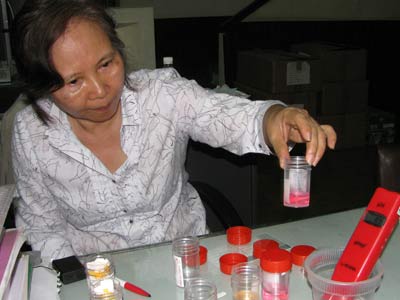Quick detection of urea in food
Test paper for urea and urea sensors was developed by a scientist. These are effective tools for housewives to choose safe food for their families.
Dr. Tran Bich Lam, Department of Chemical Engineering - Polytechnic University (National University of Ho Chi Minh City) and colleagues have just succeeded in creating 2 quick analytical tools to help identify urea in food. It is a test paper for urea and urea sensors - can give results within 10-15 minutes.

Dr. Tran Bich Lam is working on the rapid detection device of urea in food
Two-thirds of samples have high urea content
Currently, in some consumer foods, urea content is found to be quite high, causing psychological insecurity for consumers. Previously, Nha Trang Pasteur Institute once announced that 19/45 samples of tested fish sauce with urea content> 0.1 g / liter (at the request of Ho Chi Minh City Fish Sauce Association should limit the content of urea in Fish sauce is 0.05 g / liter (50 ppm) to ensure consumer health. In addition to fish sauce, in milk, seafood and many other foods can also contain high levels of urea.
Dr. Lam said that during the study, she went to survey in many places, on many products and noticed that it was remarkable that there were 21/30 suspect samples (fish, shrimp, squid, salt used) Marinating fish, ice marinated in fish, leaching from fishmeal .) results in too high urea content.
There are many reasons for the presence of urea in food, in addition to endogenous urea, urea is used to supplement the fermentation environment, used in feed for dairy cows, even for seafood. There are cases where urea is also added to cheating products to increase the total protein, resulting in misidentification of the protein content and the true nutritional value of the food. In addition, urea also occurs in polluted water and fecal contaminated food - the cause of some intestinal diseases and diseases, hepatitis A, hepatitis E . 'So, check controlling urea content in food is essential to protect consumers' health ' , said Dr. Lam.

If the fish is infected with urea, the test paper will turn red
Fast and handy results
The first tool manufactured by Dr. Lam is urea test paper. This test paper is made of a tough, tough cellulose that will keep its shape when applied to the liquid medium. In addition, there must be sufficient porosity to permeate the solution on it. This test paper works on the principle of application of enzymatic achievements for rapid analysis. When using, simply put the white end of the test paper into the solution to be tested and wait for about 15 minutes. Then, the solution will absorb itself on paper and the paper will change color. If there is urea in the solution, the color column will turn pink or red - the more urea the solution is, the darker the red will be.
The second is the urea sensor (urea biosensor). If the test paper can only detect urea solution (the detection limit is 50 ppm), the urea sensor can show how much urea is. This sensor is built on the basis of a pH meter fixed with urease enzyme. When testing, if the test solution contains urea, it will react with the enzyme to increase the pH. Based on the pH range, it is possible to know whether urea is present and how much urea is. The use is also very simple, just dip the electrode of the sensor into the solution, leave it for about 10 minutes and rely on the calibration curve to know the concentration of urea.
Can replace imported tools
In the acceptance of the research topic at the Department of Science and Technology of Ho Chi Minh City, many experts said that if commercialized, the product of Dr. Tran Bich Lam could proceed to replace the imported urea analyzers. foreign and reduce the use of analytical methods that require expensive equipment and chemicals. If commercialized, each piece of test paper costs only about 900 VND, used for one try. Biosensor sensor tools cost about VND 600,000 / unit, no time limit and number of uses.
Thanks to its usability and fast result times, these tools can become a powerful tool for housewives to choose safe food for their families and those who monitor food safety and hygiene, milk and seafood purchasing stations .
- How to identify urea-impregnated seafood
- Food poisoning 'chains'
- Fast food poisoning detection device
- The paper indicates that the yellow and purple cabbage recognize food
- Detection and conservation of wild food crops
- Rapid detection of bacteria that cause food poisoning
- Stanford scientists have successfully built batteries made from fertilizer and animal waste, which are extremely cheap
- Stomach cancer is detected through breathing
- Liquid detectors help to detect cancer fast
- Laundry tips and quick drying clothes when it rains wet
- Tool to detect rancid meat
- It will be dangerous if you deliberately eat these foods with signs after Tet
 Daily use inventions come from universities
Daily use inventions come from universities Special weight loss device helps prevent appetite
Special weight loss device helps prevent appetite 8 inventors were killed by their own inventions
8 inventors were killed by their own inventions Iran invented a motor car powered by water
Iran invented a motor car powered by water